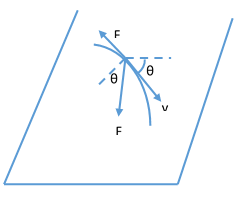Children sliding down a hill
Two children stand on a large sloping hillside that can be considered as a plane. The angle of the incline of the hillside is α . The ground is just sufficiently icy that a child would slide downhill with uniform speed as a result of receiving even the slightest impulse down the hill.
For fun, one of the children (leaning against a tree) pushes the other child with a horizontal initial speed of v 0 = 1 m / s , who then slides down the slope, as indicated by the curved arrow. What will be this child's final speed (in m / s ) if air drag is negligible and the frictional force is independent of speed?
The answer is 0.5.
This section requires Javascript.
You are seeing this because something didn't load right. We suggest you, (a) try
refreshing the page, (b) enabling javascript if it is disabled on your browser and,
finally, (c)
loading the
non-javascript version of this page
. We're sorry about the hassle.
3 solutions
What does moving down with constant speed down the slope mean?
Log in to reply
That means if a very slight push is given to the child he will start sliding down the slope/inclined. The constant speed ensures that the magnitude of the kinetic friction and the gravitational pull down the inclined are equal.
If the frictional force equals the gravitational force and the child is pushed horizontally, why would the child slide down the hill?
Log in to reply
They will be equal in magnitude but they will have different directions. So, they won't cancel each other.
I can’t see any pictures. Do you know why that Is?
@Rohit Gupta See this solution as it doesn't require rigourous integration.
Log in to reply
Wow! Great. You really thought out of the box. We generally make equations along the rectangular components but making the two equations like this is a good idea. I loved it!
Let the velocity of the child rotates by and angle θ and decreases to v in time t . It is acted upon by the two forces in the plane of the inclined plane. One is the gravitational force F and the other is the friction force.

It is being stated in the problem that the child will move down at a constant speed if he is pushed slightly down the hill. This implies that the friction force is equal to the gravitational pull down the incline. Although, in this case, the velocity of the child is not down the incline, therefore, the friction although will be equal to F but will not be opposite to the gravitational pull. Rather, it will be opposite to the instantaneous velocity.
Now, the net force perpendicular to the velocity is written as, F cos θ = m v d t d θ . The force opposite to velocity can be written as, F − F sin θ = − m d t d v . Dividing the two equations, we will get 1 − sin θ cos θ = − d v v d θ − ∫ 1 v f ( v 1 ) d v = ∫ 0 π / 2 cos θ 1 − sin θ d θ . Solving this, we will get v f = 0 . 5 m s − 1 .
This is a much, much cleaner version of the method I used.
On a side-note, trying to solve for v or θ in terms of t is a good way to make yourself pull out your hair.
Log in to reply
Yes, I agree with you. This is the method that first strike me. Although, Rahul's solution above is much simpler and have very less and easy calculations.
Let F be the downhill component of the gravitational force; according to the given above, this is equal to the frictional force.
At any given moment, let θ be the angle between the sled and the vertical.
Tangentially, m a t a n = F g , t a n − F f = F cos θ − F .
In the downhill direction, m a y = F g + F f , y = F − F cos θ .
It follows that a t a n + a y = 0 , or 0 = d t d v + d t d ( v cos θ ) = d t d v ( 1 + cos θ ) − v sin θ d t d θ = d t d v ( 1 + cos θ ) . Therefore v ( 1 + cos θ ) is a constant of the motion.
v f ( 1 + cos θ f ) = v i ( 1 + cos θ i ) ∴ v f ( 1 + 1 ) = v i ( 1 + 0 ) ∴ v f = 1 / 2 .
How are gravitational force and friction equal ?
Log in to reply
We are told that the slope is precisely slippery enough to slide down at constant speed. Thus the net force is zero; the friction force balances the downhill component of the gravitational force.